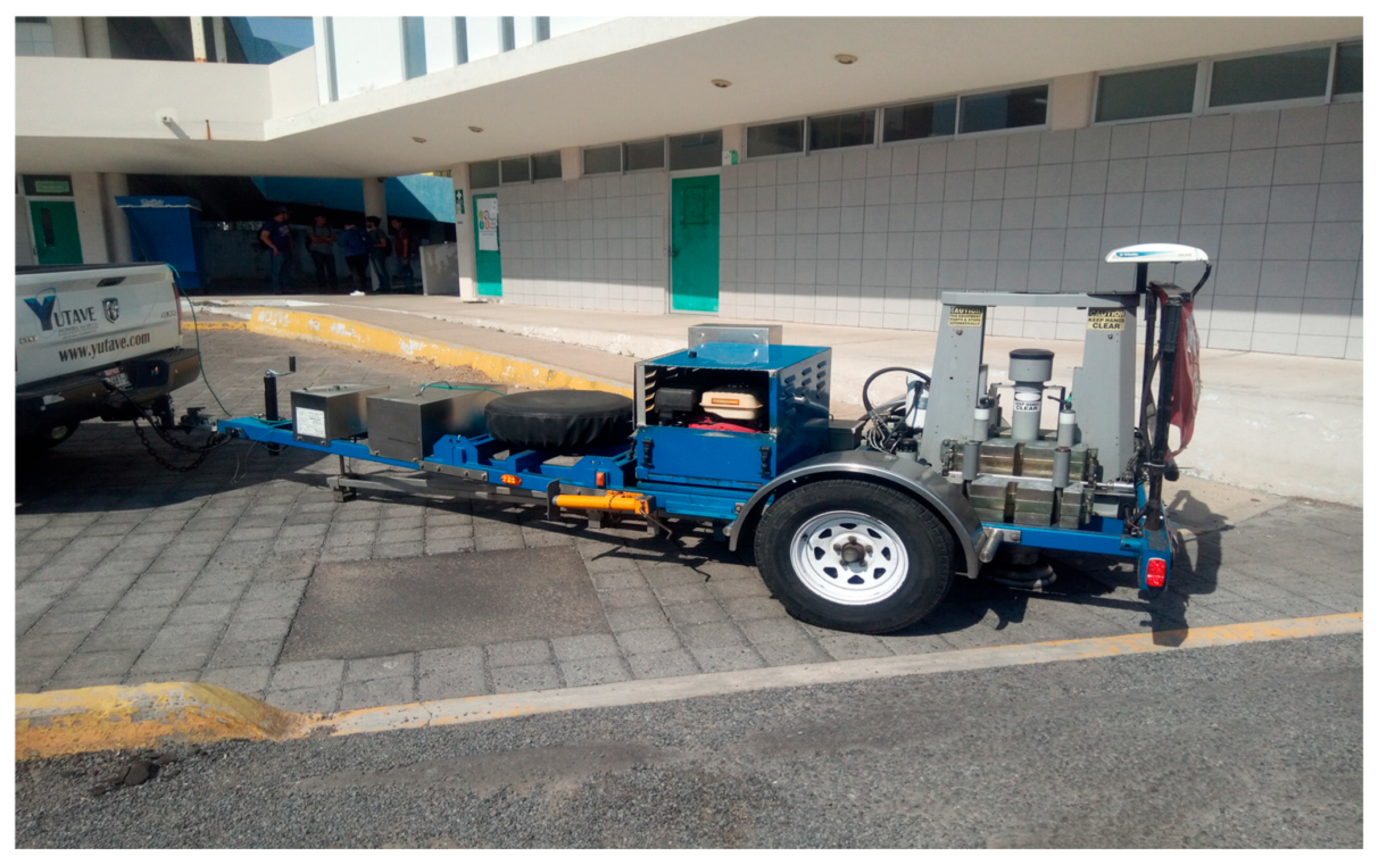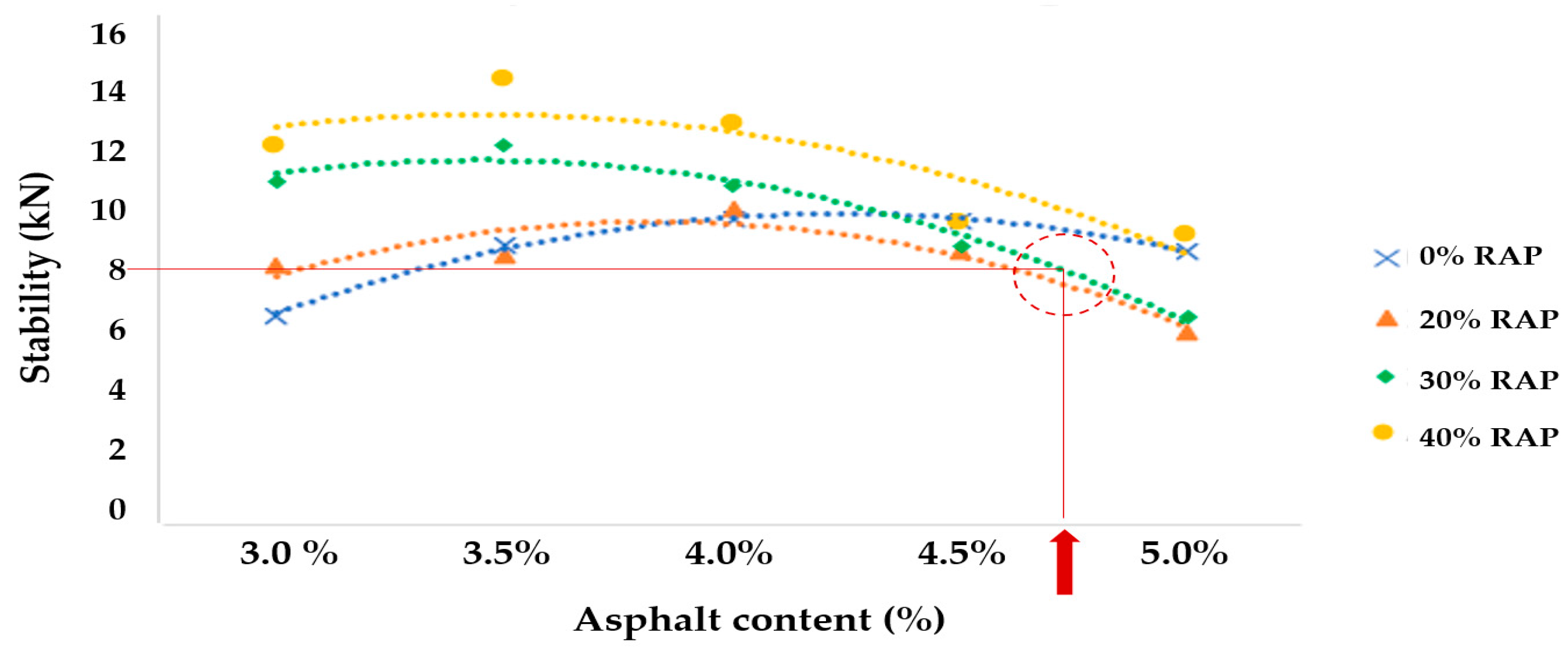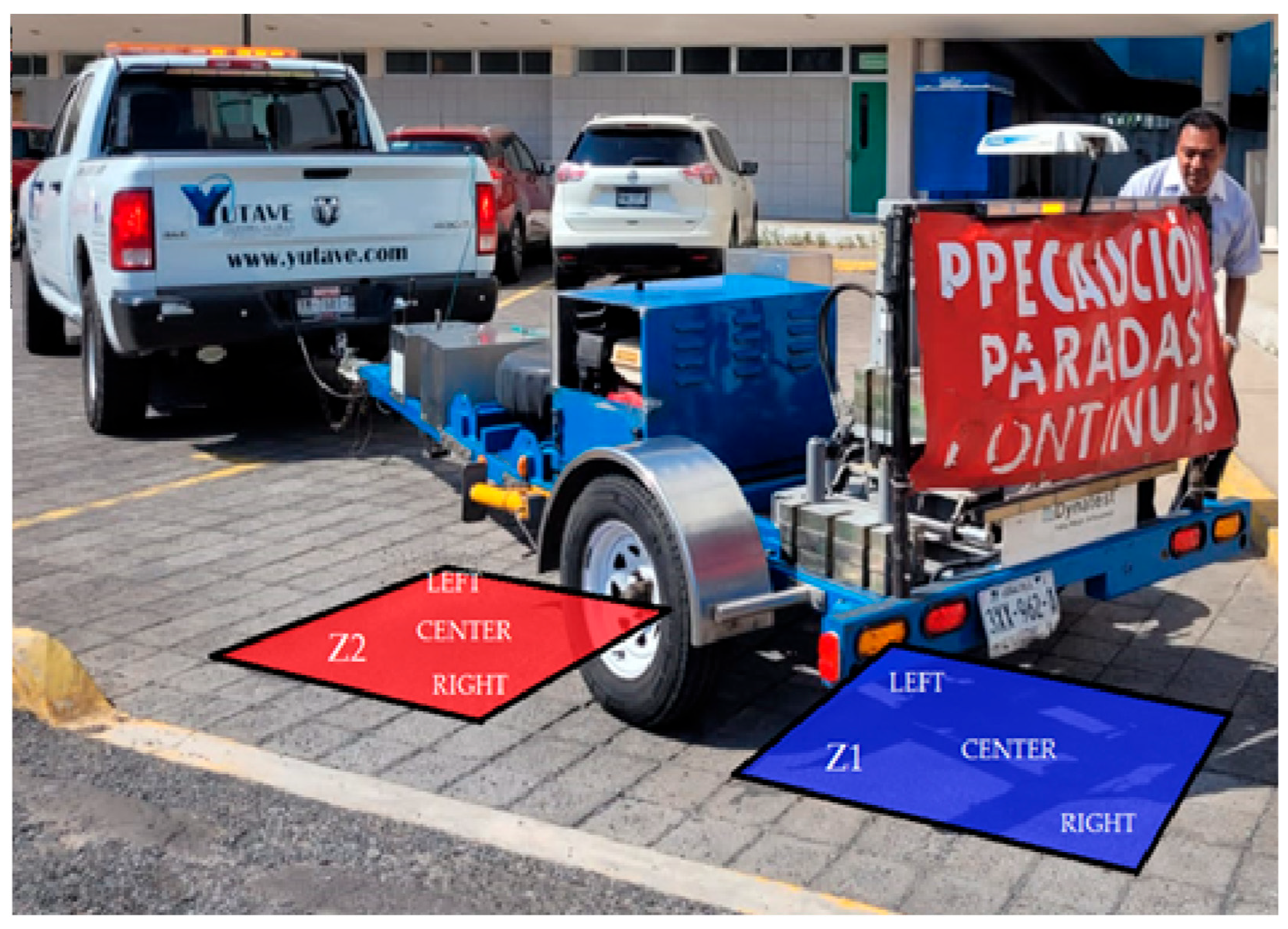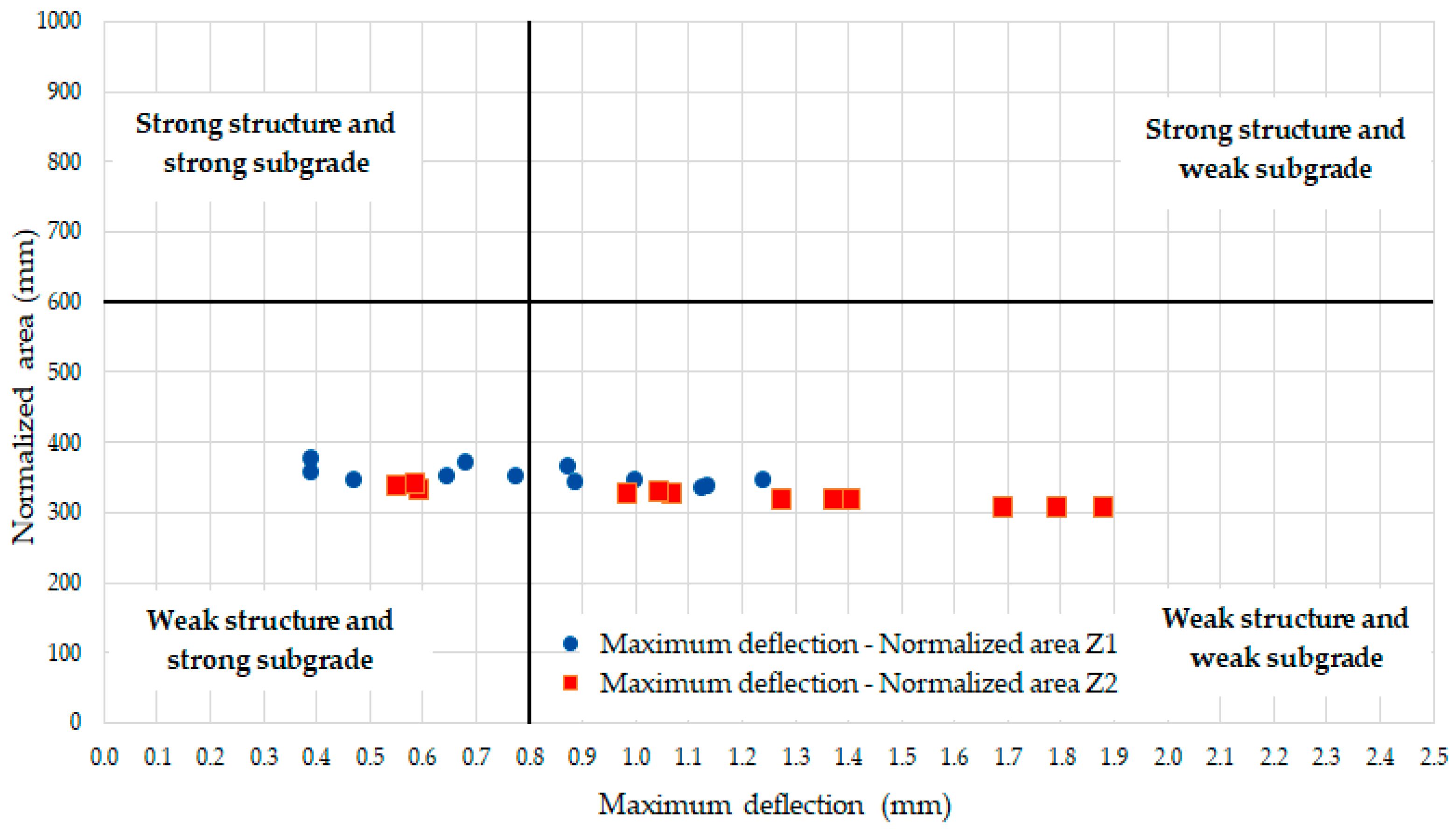Structural Evaluation with FWD of Asphalt Pavement with 30% RAP Reinforced with Fiberglass Geogrid in the Asphalt Layer
Abstract
1. Introduction
2. Materials and Methods
2.1. Materials
2.2. Methods
3. Results
3.1. Homogeneous Zones
3.1.1. Deflection Normalization
3.1.2. Temperature Correction
- Acceptable range: deflection less than or equal to 0.40 mm;
- Unacceptable range: deflection greater than 0.40 mm.
3.2. Derived Indicators from the Deflection Test
3.2.1. Normalized Area (NA0.9)
- NA0.9: normalized area in millimeters;
- D: deflection in meters.
3.2.2. Structural Index (SI)
- SI: structural index;
- Dmax: maximum deflection, millimeters;
- Pi: inflection points distance, millimeters.
3.2.3. Dynamic Stiffness Modulus (DSM)
- DSM: dynamic stiffness modules, kN/mm;
- FD: effort, kN;
- DMAX: maximum deflection, millimeters.
4. Discussion
5. Conclusions
Author Contributions
Funding
Institutional Review Board Statement
Informed Consent Statement
Data Availability Statement
Acknowledgments
Conflicts of Interest
References
- Mariyappan, R.; Palammal, J.S.; Balu, S. Sustainable use of reclaimed asphalt pavement (RAP) in pavement applications—A review. Environ. Sci. Pollut. Res. 2023, 30, 45587–45606. [Google Scholar] [CrossRef] [PubMed]
- Zhao, Y.; Goulias, D.; Peterson, D. Recycled Asphalt Pavement Materials in Transport Pavement Infrastructure: Sustainability Analysis & Metrics. Sustainability 2021, 13, 8071. [Google Scholar] [CrossRef]
- Guduru, G.; Kuna, K.K. Allowable limits for Reclaimed Asphalt Pavement (RAP) content in hot mix asphalt using simple indicative tests. Mater. Struct. 2023, 56, 27. [Google Scholar] [CrossRef]
- Bazoobandi, P.; Karimi, H.R.; Mousavi, S.R.; Karimi, F.; Aliha, M.R.M. Full range of mode I and II cracking performance of asphalt mixtures containing low to high reclaimed asphalt pavement (RAP) contents; modified by recycling agent and substituting of a softer binder. Case Stud. Constr. Mater. 2023, 19, e02487. [Google Scholar] [CrossRef]
- Si, W.; Zhang, B.; Zhang, X.; Xia, W.; Cheng, X.; Luo, X.; Hu, Y. Maximizing the circularity of asphalt pavements by improving the RAP content in recycled asphalt mixtures. Constr. Build. Mater. 2024, 438, 137316. [Google Scholar] [CrossRef]
- Fawzy, M.M.; Shrakawy, A.S.E.; Hassan, A.A.; Khalifa, Y.A. Enhancing sustainability for pavement maintenance decision-making through image processing-based distress detection. Innov. Infrastruct. Solut. 2024, 9, 58. [Google Scholar] [CrossRef]
- Alimohammadi, H.; Zheng, J.; Schaefer, V.R.; Siekmeier, J.; Velasquez, R. Evaluation of geogrid reinforcement of flexible pavement performance: A review of large-scale laboratory studies. Transp. Geotech. 2021, 27, 100471. [Google Scholar] [CrossRef]
- Qadir, A.; Gazder, U.; Choudhary, K.-N. Statistical analysis for comparing and predicting rutting resistance of asphalt pavements with rigid and flexible geogrid layers. Constr. Build. Mater. 2021, 302, 124136. [Google Scholar] [CrossRef]
- Freire, R.A.; Di Benedetto, H.; Sauzéat, C.; Pouget, S.; Lesueur, D. Crack propagation analysis in bituminous mixtures reinforced by different types of geogrids using digital image correlation. Constr. Build. Mater. 2021, 303, 124522. [Google Scholar] [CrossRef]
- Xiao, M.; Luo, R.; Yu, X. Assessment of asphalt pavement overall performance condition using functional indexes and FWD deflection basin parameters. Constr. Build. Mater. 2022, 341, 127872. [Google Scholar] [CrossRef]
- Sharbaf, M.; Ghafoori, N. Laboratory evaluation of geogrid-reinforced flexible pavements. Transp. Eng. 2021, 4, 100070. [Google Scholar] [CrossRef]
- AlShareedah, O.; Nassiri, S. Pervious concrete mixture optimization, physical, and mechanical properties and pavement design: A review. J. Clean. Prod. 2021, 288, 125095. [Google Scholar] [CrossRef]
- Markiewicz, A.; Koda, E.; Kawalec, J. Geosynthetics for Filtration and Stabilisation: A Review. Polymers 2022, 14, 5492. [Google Scholar] [CrossRef] [PubMed]
- Liu, L.; Wang, S.; Chen, X.; Cheng, H.; Quan, L.; Jiang, S.; Sun, L. Multilayered elastic medium reinforced with interfacial thin film: A theoretical model for geogrid reinforced HIR asphalt pavement. Eng. Anal. Bound. Elem. 2024, 158, 224–238. [Google Scholar] [CrossRef]
- Baadiga, R.; Balunaini, U.; Saride, S.; Madhav, M.R. Influence of Geogrid Properties on Rutting and Stress Distribution in Reinforced Flexible Pavements under Repetitive Wheel Loading. J. Mater. Civ. Eng. 2021, 33, 04021338. [Google Scholar] [CrossRef]
- Solatiyan, E.; Bueche, N.; Carter, A. Laboratory evaluation of interfacial mechanical properties in geogrid-reinforced bituminous layers. Geotext. Geomembr. 2021, 49, 895–909. [Google Scholar] [CrossRef]
- Abdel-Jaber, M.; Al-shamayleh, R.A.; Ibrahim, R.; Alkhrissat, T.; Alqatamin, A. Mechanical properties evaluation of asphalt mixtures with variable contents of reclaimed asphalt pavement (RAP). Results Eng. 2022, 14, 100463. [Google Scholar] [CrossRef]
- Pan, Y.; Liu, G.; Li, Z.; Zhao, Y. Survival analysis of rutting failures in hot in-place recycling maintained asphalt pavements using field data. Case Stud. Constr. Mater. 2024, 20, e02762. [Google Scholar] [CrossRef]
- Choudhary, L.; Bansal, S.; Kalra, M.; Dagar, L. Mechanical evaluation of recycled aggregate mixes and its application in reclaimed asphalt pavement (RAP) stretch. Beni-Suef Univ. J. Basic Appl. Sci. 2022, 11, 127. [Google Scholar] [CrossRef]
- Kumar Pradhan, S.; Das, U.; Ranjan Patra, A. Utilization of reclaimed asphalt pavement (RAP) materials in HMA mixtures for flexible pavement construction. Mater. Today Proc. 2023, S2214785323023908. [Google Scholar] [CrossRef]
- Pradhan, S.K.; Sahoo, U.C. Influence of softer binder and rejuvenator on bituminous mixtures containing reclaimed asphalt pavement (RAP) material. Int. J. Transp. Sci. Technol. 2022, 11, 46–59. [Google Scholar] [CrossRef]
- Li, W.; Han, S.; Han, X.; Yao, Y. Experimental and numerical analysis of mechanical properties of geocell reinforced reclaimed construction waste composite base layer. Constr. Build. Mater. 2021, 304, 124587. [Google Scholar] [CrossRef]
- Szafranko, E. Problem of selection of suitable geosynthetics for the strengthening of subgrade in road construction, selection of assessment criteria. ACTA Sci. Pol.-Archit. Bud. 2021, 20, 93–101. [Google Scholar] [CrossRef]
- Yoo, C. Geosynthetics in Sustainable Transportation Infrastructure Construction. E3S Web Conf. 2023, 368, 01004. [Google Scholar] [CrossRef]
- Correia, N.S.; Mugayar, A.N. Effect of binder rates and geogrid characteristics on the shear bond strength of reinforced asphalt interfaces. Constr. Build. Mater. 2021, 269, 121292. [Google Scholar] [CrossRef]
- Han, J.; Thakur, J.K. Sustainable roadway construction using recycled aggregates with geosynthetics. Sustain. Cities Soc. 2015, 14, 342–350. [Google Scholar] [CrossRef]
- Imjai, T.; Pilakoutas, K.; Guadagnini, M. Performance of geosynthetic-reinforced flexible pavements in full-scale field trials. Geotext. Geomembr. 2019, 47, 217–229. [Google Scholar] [CrossRef]
- Huang, W.; Liang, S.; Wei, Y. Surface deflection-based reliability analysis of asphalt pavement design. Sci. China Technol. Sci. 2020, 63, 1824–1836. [Google Scholar] [CrossRef]
- Camacho-Garita, E.; Puello-Bolaño, R.; Laurent-Matamoros, P.; Aguiar-Moya, J.P.; Loria-Salazar, L. Structural Analysis for APT Sections Based on Deflection Parameters. Transp. Res. Rec. J. Transp. Res. Board 2019, 2673, 313–322. [Google Scholar] [CrossRef]
- Liao, J.; Lin, H.; Li, Q.; Zhang, D. A Correction Model for the Continuous Deflection Measurement of Pavements Under Dynamic Loads. IEEE Access 2019, 7, 154770–154785. [Google Scholar] [CrossRef]
- Vargas, J.R.R.; Castro, S.A.Z.; Estrada, R.S. Evaluación del Sistema RAP-Geomalla en Carpetas de Pavimento Flexible Para Suprimir la Fisuración Refleja. In Proceedings of the Congreso Academia Journals Hidalgo 2023, Hidalgo, Mexico, 18–20 October 2023; pp. 279–284. [Google Scholar]
- Imjai, T.; Garcia, R.; Rassameekobkul, W.; Sofri, L.A.; Wicaksono, A. Service Performance of Porous Asphalt Mixtures in Thailand: Laboratory and Full-Scale Field Tests. Int. J. Pavement Res. Technol. 2024, 1–18. [Google Scholar] [CrossRef]
- ASTM D1883-21; Standard Test Method for California Bearing Ratio (CBR) of Laboratory-Compacted Solis. American Society for Testing and Materials—ASTM: West Conshohocken, PA, USA, 2021. [CrossRef]
- Secretaría de Infraestructura, Comunicaciones y Transportes, “Calidad de Materiales Asfálticos”. SICT, 2022. Available online: https://normas.imt.mx/storage/normativa/N-CMT-4-05-001-22.pdf (accessed on 27 March 2025).
- Secretaría de Infraestructura, Comunicaciones y Transportes, “Materiales Pétreos Para Mezclas Asfálticas”. SICT, 2017. Available online: https://normas.imt.mx/storage/normativa/N-CMT-4-04-17.pdf (accessed on 27 March 2025).
- Mabrouk, G.M.; Elbagalati, O.S.; Dessouky, S.; Fuentes, L.; Walubita, L.F. 3D-finite element pavement structural model for using with traffic speed deflectometers. Int. J. Pavement Eng. 2022, 23, 4065–4079. [Google Scholar] [CrossRef]
- Sawangsuriya, A.; Imjai, T.; Malaikrisanachalee, S. Structural Responses of Flexible Pavement Subjected to Different Axle Group Loads. Walailak J. Sci. Tech. 2020, 17, 1356–1366. [Google Scholar] [CrossRef]
- Secretaría de Infraestructura Comunicaciones y Transportes, “Método Marshall Para Mezclas Asfálticas de Granulometría Densa”. SICT, 2023. Available online: https://normas.imt.mx/storage/normativa/M-MMP-4-05-034-23.pdf (accessed on 27 March 2025).
- Secretaría de Infraestructura, Comunicaciones y Transportes, “Calidad de Cementos Asfálticos Según su Grado de Desempeño (PG)”. SICT, 2018. Available online: https://normas.imt.mx/storage/normativa/N-CMT-4-05-004-18.pdf (accessed on 27 March 2025).
- ASTM D6927-22; Standard Test Method for Marshall Stability an Flow of Asphalt Mixtures. American Society for Testing and Materials—ASTM: West Conshohocken, PA, USA, 2022. [CrossRef]
- Secretaría de Infraestructura, Comunicaciones y Transportes, “Determinación de las Deflexiones de un Pavimento(DEF)”. SICT, 2017. Available online: https://normas.imt.mx/storage/normativa/N-CSV-CAR-1-03-010-17.pdf (accessed on 12 February 2025).
- American Association of State Highway and Transportation Officials. AASHTO Guide for Design of Pavement Structures; AASHTO: Washington, DC, USA, 1993.
- Pais, J.; Santos, C.; Pereira, P.; Kaloush, K. The adjustment of pavement deflections due to temperature variations. Int. J. Pavement Eng. 2020, 21, 1585–1594. [Google Scholar] [CrossRef]
- Secretaría de Infraestructura, Comunicaciones y Transportes, “Determinación de las Deflexiones Con Equipo de Impacto en Pavimentos Flexibles.” 2017. Available online: https://normas.imt.mx/storage/normativa/M-MMP-4-07-020-17.pdf (accessed on 13 February 2025).
- Yang, S.; Ceylan, H.; Gopalakrishnan, K.; Kim, S.; Taylor, P.C.; Alhasan, A. Characterization of environmental loads related concrete pavement deflection behavior using Light Detection and Ranging technology. Int. J. Pavement Res. Technol. 2018, 11, 470–480. [Google Scholar] [CrossRef]
- Vyas, V.; Singh, A.P.; Srivastava, A. Prediction of asphalt pavement condition using FWD deflection basin parameters and artificial neural networks. Road Mater. Pavement Des. 2021, 22, 2748–2766. [Google Scholar] [CrossRef]
- Rabbi, M.F.; Mishra, D. Using FWD deflection basin parameters for network-level assessment of flexible pavements. Int. J. Pavement Eng. 2021, 22, 147–161. [Google Scholar] [CrossRef]
- ASTM D2487-17; Standard Practice for Classification of Soils for Engineering Purposes (Unified Soil Classification System). American Society for Testing and Materials—ASTM: West Conshohocken, PA, USA, 2017. [CrossRef]
- Orozco Santoyo Raúl Vicente, “Evaluacion de Pavimentos Flexibles Con Metodos No Destructivos”, Universidad Nacional Autónoma de México, México, 2005. Available online: https://repositorio.unam.mx/contenidos/97684 (accessed on 24 May 2024).
- Xue, W.; Flintsch, G.W.; Diefenderfer, B.K. Measuring Pavement Permanent Deformation in Accelerated Pavement Testing. Transp. Res. Rec. J. Transp. Res. Board 2020, 2674, 340–348. [Google Scholar] [CrossRef]
- Goktepe, A.B.; Agar, E.; Lav, A.H. Advances in backcalculating the mechanical properties of flexible pavements. Adv. Eng. Softw. 2006, 37, 421–431. [Google Scholar] [CrossRef]
- Inés, B.C.G. Evaluación Estructural De Pavimentos Flexibles Con Métodos De Inteligencia Artificial Y Auscultación No Destructiva. Ph.D. Thesis, Universidad Nacional Autónoma de México, Mexico City, Mexico, 2012. Available online: http://www.ptolomeo.unam.mx:8080/xmlui/bitstream/handle/132.248.52.100/5145/Tesis.pdf?sequence=1 (accessed on 24 May 2024).
- Ramírez-Vargas, J.R.; Zamora-Castro, S.A.; Herrera-May, A.L.; Sandoval-Herazo, L.C.; Salgado-Estrada, R.; Diaz-Vega, M.E. A Review of Sustainable Pavement Aggregates. Appl. Sci. 2024, 14, 7113. [Google Scholar] [CrossRef]
















| Property | 0% | 20% | 30% | 40% |
|---|---|---|---|---|
| Bulk specific gravity of compacted mixture (Gmb) ± 0.02 g/cm3 | 2.40 | 2.38 | 2.36 | 2.34 |
| Percentage of air voids by volume (Pa) ± 1.0% | 4.00 | 5.00 | 6.00 | 7.50 |
| Voids in the mineral aggregate (VMA) ± 0.5% | 16.00 | 15.50 | 15.00 | 14.50 |
| Volume of absorbed binder (Vba) ± 0.5% | 2.00 | 2.50 | 3.00 | 3.50 |
| Control | Standardization Effort (kPa) | S1 0 | S2 300 | S3 450 | S4 600 | S5 900 | S6 1200 | S7 1800 |
|---|---|---|---|---|---|---|---|---|
| Z1 RIGHT | 400 | 0.712 | 0.302 | 0.190 | 0.128 | 0.071 | 0.052 | 0.031 |
| 700 | 1.182 | 0.511 | 0.321 | 0.221 | 0.123 | 0.088 | 0.058 | |
| 900 | 1.507 | 0.640 | 0.404 | 0.273 | 0.151 | 0.114 | 0.076 | |
| 1100 | 1.885 | 0.799 | 0.506 | 0.337 | 0.181 | 0.142 | 0.094 | |
| Z1 CENTER | 400 | 0.590 | 0.286 | 0.183 | 0.124 | 0.072 | 0.047 | 0.032 |
| 700 | 1.033 | 0.491 | 0.312 | 0.210 | 0.120 | 0.083 | 0.055 | |
| 900 | 1.323 | 0.607 | 0.388 | 0.262 | 0.152 | 0.106 | 0.073 | |
| 1100 | 1.698 | 0.639 | 0.478 | 0.312 | 0.178 | 0.124 | 0.091 | |
| Z1 LEFT | 400 | 0.597 | 0.261 | 0.164 | 0.118 | 0.071 | 0.050 | 0.030 |
| 700 | 0.996 | 0.419 | 0.262 | 0.192 | 0.114 | 0.080 | 0.052 | |
| 900 | 1.371 | 0.565 | 0.343 | 0.249 | 0.146 | 0.107 | 0.075 | |
| 1100 | 1.752 | 0.705 | 0.419 | 0.301 | 0.173 | 0.126 | 0.093 | |
| Z2 RIGHT | 400 | 0.730 | 0.300 | 0.175 | 0.116 | 0.065 | 0.048 | 0.031 |
| 700 | 1.322 | 0.530 | 0.306 | 0.199 | 0.109 | 0.082 | 0.056 | |
| 900 | 1.750 | 0.679 | 0.389 | 0.249 | 0.133 | 0.102 | 0.074 | |
| 1100 | 2.363 | 0.874 | 0.490 | 0.301 | 0.154 | 0.129 | 0.094 | |
| Z2 CENTER | 400 | 0.703 | 0.296 | 0.178 | 0.111 | 0.071 | 0.050 | 0.032 |
| 700 | 1.257 | 0.515 | 0.302 | 0.169 | 0.115 | 0.086 | 0.052 | |
| 900 | 1.637 | 0.654 | 0.375 | 0.200 | 0.145 | 0.105 | 0.067 | |
| 1100 | 2.183 | 0.856 | 0.471 | 0.205 | 0.192 | 0.133 | 0.092 | |
| Z2 LEFT | 400 | 0.757 | 0.323 | 0.178 | 0.122 | 0.074 | 0.052 | 0.031 |
| 700 | 1.348 | 0.546 | 0.296 | 0.200 | 0.121 | 0.088 | 0.055 | |
| 900 | 1.784 | 0.685 | 0.362 | 0.247 | 0.150 | 0.112 | 0.075 | |
| 1100 | 2.326 | 0.854 | 0.434 | 0.293 | 0.176 | 0.129 | 0.091 |
| Origin of the Variations | Sum of Squares | Degrees of Freedom | Mean of Squares | F | Probability | Critical Value for F |
|---|---|---|---|---|---|---|
| Between checkpoints | 0.1281636 | 5 | 0.025632713 | 0.7912423 | 0.569689626 | 2.772853153 |
| Inside the checkpoints | 0.5831195 | 18 | 0.03239553 | |||
| Total | 0.7112831 | 23 |
Disclaimer/Publisher’s Note: The statements, opinions and data contained in all publications are solely those of the individual author(s) and contributor(s) and not of MDPI and/or the editor(s). MDPI and/or the editor(s) disclaim responsibility for any injury to people or property resulting from any ideas, methods, instructions or products referred to in the content. |
© 2025 by the authors. Licensee MDPI, Basel, Switzerland. This article is an open access article distributed under the terms and conditions of the Creative Commons Attribution (CC BY) license (https://creativecommons.org/licenses/by/4.0/).
Share and Cite
Ramírez-Vargas, J.R.; Zamora-Castro, S.A.; Herrera-May, A.L.; Melo-Santiago, R.; Sandoval Herazo, L.C.; Pérez-Madrigal, D. Structural Evaluation with FWD of Asphalt Pavement with 30% RAP Reinforced with Fiberglass Geogrid in the Asphalt Layer. CivilEng 2025, 6, 44. https://doi.org/10.3390/civileng6030044
Ramírez-Vargas JR, Zamora-Castro SA, Herrera-May AL, Melo-Santiago R, Sandoval Herazo LC, Pérez-Madrigal D. Structural Evaluation with FWD of Asphalt Pavement with 30% RAP Reinforced with Fiberglass Geogrid in the Asphalt Layer. CivilEng. 2025; 6(3):44. https://doi.org/10.3390/civileng6030044
Chicago/Turabian StyleRamírez-Vargas, Jaime R., Sergio A. Zamora-Castro, Agustín L. Herrera-May, Rafael Melo-Santiago, Luis Carlos Sandoval Herazo, and Domingo Pérez-Madrigal. 2025. "Structural Evaluation with FWD of Asphalt Pavement with 30% RAP Reinforced with Fiberglass Geogrid in the Asphalt Layer" CivilEng 6, no. 3: 44. https://doi.org/10.3390/civileng6030044
APA StyleRamírez-Vargas, J. R., Zamora-Castro, S. A., Herrera-May, A. L., Melo-Santiago, R., Sandoval Herazo, L. C., & Pérez-Madrigal, D. (2025). Structural Evaluation with FWD of Asphalt Pavement with 30% RAP Reinforced with Fiberglass Geogrid in the Asphalt Layer. CivilEng, 6(3), 44. https://doi.org/10.3390/civileng6030044












